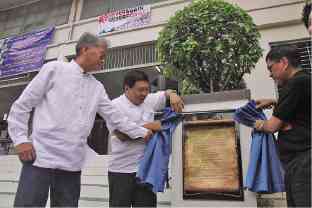
Lawyer Filemon Nolaso (left), UPLB Chancellor Fernando Sanchez Jr. (center) and College of Arts and Sciences Dean Felino Lansigan unveil the “Hagdan ng Malayang Kamalayan” marker. —KIMMY BARAOIDAN
LOS BAÑOS, Laguna—The iconic steps behind the Oblation at the University of the Philippines Los Baños (UPLB) campus here is a silent witness to years of disquiet and youth protests against state repression.
“A lot of things happened here,” said lawyer Filemon Nolasco, referring to the Humanities steps in the College of Arts and Sciences (CAS) building.
“During martial law, the university would not allow its auditoriums and facilities to be used for symposiums. The Humanities steps served as an alternative venue for students to hold discussions,” said Nolasco, who chaired UPLB’s student council in 1978, the first to have been formed during martial law.
Heroes, martyrs
On March 9, the Bantayog Project, an initiative of UPLB activists to honor their fallen comrades, unveiled a marker renaming the Humanities steps into the “Hagdan ng Malayang Kamalayan,” the first step toward putting up a memorial for martial law heroes and present-day martyrs from UPLB.
That day, portraits of the dead were hung on the ceiling of the CAS building, as candles scattered on the Humanities steps burned in the humid afternoon.
There were pictures of Jessica Sales, Risalina Ilagan, Cristina Catalla and Gerardo Faustino, among the many other UPLB alumni who disappeared or were killed during martial law.
Also displayed were photos of Sherlyn Cadapan, a UP Diliman student from this town, who was abducted with fellow activist Karen Empeño in 2006; and of UPLB alumnus, Dr. Dreyfuss Perlas, who was gunned down in Lanao del Norte province early this month.
Funded through contributions, the marker is a 2-feet-by-3-feet bronze plaque mounted on a marble slab done by artists Emmanuel Garibay and Lito Mondejar.
On it is an image of a broken barbed wire that symbolizes “freedom” at the cost of those who died fighting the dictatorship, according to Nolasco, who leads the Bantayog Project.
“Ang pook na ito ay naging lugar para sa alternatibong kaalaman, pagbuo ng komunidad, aktibismo, at sa paghubog ng pambansang kamalayan. Dito nagtipon ang mga mag-aaral, guro at kawani ng pamantasan at mga sektor sa Timog Katagalugan na nakibaka laban sa Diktadura noong panahon ng Batas Militar. Marami sa kanila ang inaresto, tinortyur, pinaslang at sapilitang pinaglaho (This place was a venue for alternative learning, community building, activism and shaping national consciousness. University students, teachers and personnel and sectors from Southern Tagalog who fought the dictatorship during martial law gathered here. Many of them were arrested, tortured, killed and forcibly disappeared),” the marker reads.
Dr. Fernando Sanchez, UPLB chancellor, said renaming the Humanities steps would allow political discussions to continue inside the campus amid controversies hounding the nation today.
“Every time we pass by this spot, let us share a moment to thank and honor [the martyrs] for their sacrifices,” he said.
Vigilance
Nolasco said the Bantayog Project had long been planned but it was only after the burial of strongman Ferdinand Marcos at the Libingan ng mga Bayani in November last year that things began taking shape.
Communication student Christiana Danica Despi described the Humanities steps as a “center of free thinking.”
“By renaming it, we give life to a part of history that we should never forget,” said another student, Patricia Danielle Zamora, 20.
CAS Dean Felino Lansigan said the marker should promote critical thinking and remind people of their accountability to the nation.
Staying vigilant is the only way to fight dictatorship, especially as threats of martial law surface in the current administration, Nolasco said.
“All these bombings, killings [and] this ‘state of lawlessness’ are the same indications used by Marcos [when he declared martial law in 1972],” Nolasco said. “We see parallelisms [with the Duterte administration] and these are scary,” he added.